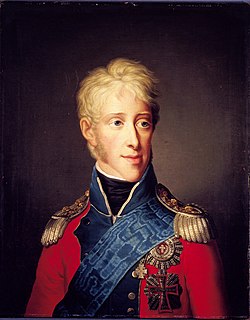Frederick VI of Denmark
| Frederick VI | |
|---|---|
| King of Denmark and Norway | |
 | |
| Reign | 1808-1839 (Denmark) (Regency from 1784) 1808-1814 (Norway) |
| Predecessor | Christian VII |
| Successor | Christian VIII |
| Father | Christian VII |
| Mother | Caroline Matilda |
King Frederick VI of Denmark and Norway (January 28, 1768 - December 3, 1839), reigned as King of Denmark from 1808 to 1839, and as king of Norway from 1808 to 1814. He also served as Regent of Denmark from 1784 to 1808 under his father's name, just like his British cousin The Prince of Wales, later King George IV. His mother, Caroline Matilda, was a sister of King George III. His father, Christian VII, had major psychological problems, including suspected schizophrenia, expressed by catatonic periods, that resulted in his standing down from power for most of his reign.
During the regency, Frederick instituted widespread liberal reforms with the assistance of Chief Minister Andreas Peter Bernstorff, including the abolition of serfdom in 1788. Crises encountered during his reign include disagreement with the British over neutral shipping. This resulted in two British attacks on Danish shipping in 1801 and 1807. The former attack is known as the Battle of Copenhagen.
His wife was his first cousin Marie Sophie Friederike of Hesse-Cassel, a member of a German family with close marriage links with the Royal families of both Denmark and Great Britain. They married in 1790 and had eight children. The youngest of them, Princess Wilhelmine, became the wife of the future Frederick VII of Denmark. However, none of Frederick VI's sons survived infancy and when he died, he was succeeded by his cousin, Christian VIII of Denmark.
When the throne of Sweden showed signs of becoming unoccupied in 1809, Frederick was interested in becoming elected there, too. Frederick actually was the first monarch of Denmark and Norway to descend from Gustav I of Sweden who had secured Sweden's independence after union period with other Scandinavian countries. (Also Frederick's sister was such descendant, both through their mother and her mother. As well as Hereditary Prince Frederick of Denmark, their uncle, who descended through queen Juliane.) However, firstly Frederick's brother-in-law the prince Augustus of Augustenborg got elected, then the French Marshal Bernadotte.
After his defeat in the Napoleonic Wars 1814 and the loss of Norway Frederick VI, carried through an authoritatarian and reactionary course quite giving up the liberal ideas of his years as a prince regent. Censorship and suppression of all opposition together with bad economic terms of the country made this period of his reign somewhat gloomy, though the king himself in general maintained his position of a "patriarch" and a well-meaning autocrat. From the 1830s the economic depression was eased a bit and from 1834 the king reluctantly accepted a small democratic innovation by the creation of the Assemblies of the Estate.
The surviving children of King Frederick VI and Queen Marie Sophie Frederikke were their two daughters:
- Caroline of Denmark (1793-1881), married to her father's first cousin Frederick Ferdinand of Denmark, d. 1863 some months before his nephew Frederick VII of Denmark, Hereditary Prince of Denmark, son of Christian VIII of Denmark. Childless.
- Wilhelmine of Denmark (1808-1891), firstly married to her second cousin Prince Frederik of Denmark, the future Frederick VII of Denmark, but they divorced, and she married secondly Duke Charles of Lyksborg (=Duke of Glucksburg), who was eldest brother of the future Christian IX of Denmark. Both her marriages were childless.
Frederick VI was known as a patron of astronomy and in 1832 offered gold medal prizes to anyone who discovered a comet using a telescope. His successors continued this until 1850. The prize was terminated in the aftermath of the First War of Schleswig.
After discovery of Haraldskær Woman in a peat bog in Jutland in the year 1835, Frederick VI ordered a royal interment in an elaborately carved sarcophagus for the Iron Age mummy, decreeing it to be the body of Queen Gunhild. Later this identity proved incorrect, but the action suited his political agenda of the time.
Template:Succession box one to two